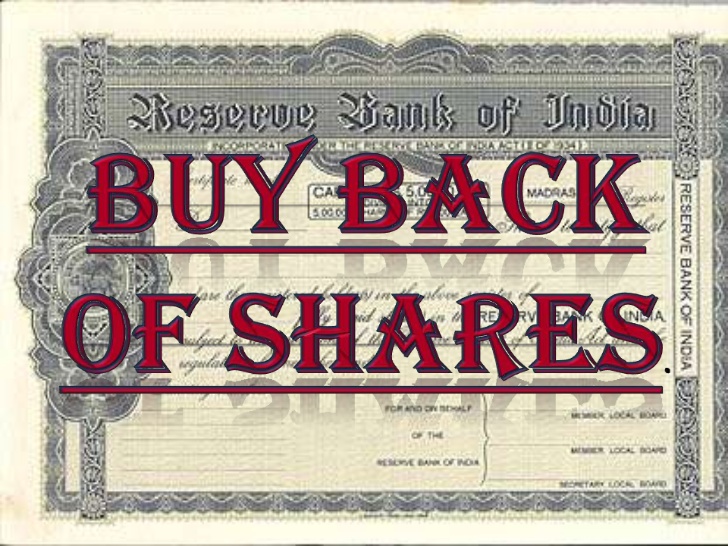In this blog post, Pramit Bhattacharya, Student, Damodaram Sanjivayya National Law University, writes about the concept of Capital Restructuring through Buybacks of Shares. This post highlights the different methods of buybacks which are used by a company to repurchase its shares. This post also looks into the provisions which governed buybacks of shares under both Companies Act, 1956 and Companies Act, 2013.
In today’s competitive world, and dynamic market condition, a company, has to adapt itself and reinvent itself to maintain its competitiveness and survive in the market. Financial, managerial and operational activities are often subject to restructuring to maintain this competitive advantage.
Capital restructuring falls under operational restructuring framework. It is a change in the capital structure of a company to deal with a shift in the financial stability of the business. Buyback of shares or stock purchase is one of the most prominent methods companies use to restructure their capital structure. The procedure through which a company acquires its stock from the market is called buyback of shares. One motive to buyback shares is to increase the value of the shares. By purchasing the shares available in the market, the supply of the shares reduce when demand remains the same. This enhances the value of the shares. The second motive of a buyback is to eliminate any threat of controlling shares. When a company has an excess of cash, the company buybacks its shares. A buyback is also done to eliminate the risk of takeover from any other company.
 There are many benefits of a buyback of shares. Buyback can be considered as one tome return of cash. Instead of paying dividends a company can use the excess cash to repurchase the shares and increase their value. Share buy-backs are also one of the quickest ways to restructure the capital.
There are many benefits of a buyback of shares. Buyback can be considered as one tome return of cash. Instead of paying dividends a company can use the excess cash to repurchase the shares and increase their value. Share buy-backs are also one of the quickest ways to restructure the capital.
On the other hand, engaging in buybacks too often may have certain negative impacts. First of all, when a company is using cash to buyback the shares, the liquid assets gets eroded, and the company may lose growth opportunities. Secondly, the market may perceive this as a danger sign that the company does not have any profitable venture in which they can invest and hence it’ll impact the company. Also, if the repurchases are not adequately managed, there stands a huge risk of insolvency also.
The process of buyback includes several methods like open market purchase, private negotiations with the shareholders and tender purchase.
In the case where the method of tender purchase is used, it is to buyback a large number of shares. The company floats its cash in the market with a few conditions like how many shares the company wants to repurchase, at what price the company will repurchase the shares, and till what time such tender offer will be kept opened.
In markets, which are developed, the method of open market purchases is preferred. Firstly, it is cheaper than tender purchase. And secondly, they can be spread over a longer period. This method is used to repurchase a small number of shares at a time, instead of a significant number of shares at one go.
 Coming to private negotiations, this method is used to eliminate the threat from any individual who seeks to gain controlling shares in the company. In the case of this procedure, a small number of investors are involved who hold a large percentage of shares. To summarize, there can be three ways of buyback-[1]
Coming to private negotiations, this method is used to eliminate the threat from any individual who seeks to gain controlling shares in the company. In the case of this procedure, a small number of investors are involved who hold a large percentage of shares. To summarize, there can be three ways of buyback-[1]
- Repurchase through tender offer
- Repurchase through open market
- Repurchase through personal negotiation
Under the Companies Act, 1956, the buyback of shares was regulated by Section 77A, 77AA, and 77B. This was before the Act of 2013. The Security Exchange Board of India also formulated rules regarding buyback of shares which were given under the SEBI (Buyback of Securities) Regulations, 1999. Under the Companies Act, 2013, buyback of securities is dealt with, under section 68-70.
Buyback under the Companies Act, 1956
Earlier companies were not allowed to purchase their shares, apart from a few exceptions which were given under Section 77 of the Companies Act, 1956. Through the Companies (Amendment) Act, 1999, Section 77A was inserted, and the change was made, and companies were allowed to buyback their shares. Sub-section (1) mentions the funds through which buyback could be done. The sources of funds which were allowed to be used were the proceeds from the earlier issue of shares, the premium on securities and the free reserves of the company.[2] No repurchase of the same kind of shares is allowed from the proceeds of the earlier issues.
Sub-section (2) states the formalities which are to be followed. There has to be a provision in the Articles of the Company, which authorizes a buyback of shares. When such authority is exercised, a special resolution by shareholders should be passed. This allows for buyback of shares to the extent of 25% of free reserves and total-paid up capital of the company. A resolution by Board of Directors can also be passed; wherein they can decide to buyback shares of the company. But the extent of the buyback is limited to 10% of the total paid-up equity capital and free reserves of the company.[3]
 If a resolution is passed authorizing a purchase of shares but it does not fulfill the statutory regulations, then the resolution will not have a binding force. It cannot be enforced against the company.
If a resolution is passed authorizing a purchase of shares but it does not fulfill the statutory regulations, then the resolution will not have a binding force. It cannot be enforced against the company.
Another important thing which is essential that the company has to ensure stakeholders about its financial status. A declaration of solvency is to be given to SEBI and Registrar of Companies, and this declaration has to be given even before the resolution for a buyback is passed.[4] Also, in case a company has decided to buyback its shares, it cannot issue any new shares or securities of the same kind within six months.[5] However, the company is under no restriction to issue bonus shares and discharge any of its existing or previous obligations. The restriction which is placed on the company is only with regards to the type of shares which has been bought back. They are free to issue any different kind of securities.
The buyback can’t be done through any other channel or any other company. The issuer has to buyback the securities directly. Buyback even through subsidiaries is not allowed. The repurchase can’t be done through any investment company also.[6] A company cannot repurchase its shares or go for buyback if it has defaulted in repayment of a term loan or payment of deposits or redemption of debentures and preference shares.
Buyback under Companies Act, 2013 and the Changes Made
Under the 1956 Act, Section 77A (4) mentioned that the buyback has to be done within 12 months after passing the resolution for it. This discouraged many companies for fixing a specific time frame for the buyback options. They used to keep the option open for the entire 12 months. But many instances have happened where the company couldn’t get even the minimum number of shares which were required for a buyback. It had also been observed that companies use to exercise their buyback option at their discretion and the price they quoted for the shares differed from the current market price that prevailed. There was no specific provision either in the Companies Act, 1956 or the SEBI Regulations which mentioned the quantity and price of the securities which the companies wanted to buyback. One more thing which was observed that the companies used this option to artificially increase the price of their securities by creating a demand-supply flux.
 Under the 2013 Act, buyback of securities is governed by sections 68-70. Changes have been made by the new Act regarding finances and funding, where the company looks to but back share for the benefit of the employees. This is allowed, only if through a special resolution, the company approves the scheme.[7]
Under the 2013 Act, buyback of securities is governed by sections 68-70. Changes have been made by the new Act regarding finances and funding, where the company looks to but back share for the benefit of the employees. This is allowed, only if through a special resolution, the company approves the scheme.[7]
Here are some significant changes which have been introduced through the new Act- [8]
- The 2013 Act has added compliance with provisions relating to declaration of dividend as an eligibility condition for buy-back.[9]
- With the approval of the General Body, buyback up to 25% of free reserves and paid up capital is allowed. In the case of buyback of equity shares, the buyback is limited to the extent of 25% of the paid-up equity capital only.[10] The exclusion of a number of free reserves decreases the amount substantially; wherein buyback wouldn’t be viable for the company in most cases. This restriction is there to protect the interest of equity shareholders of the company.
- The new Act also states that there should be a minimum gap of one year between two buybacks. Under the 1956 Act, this restriction was only applicable to buybacks which were approved by the Board. But now, such restriction is placed even upon buybacks which have been approved by the General Body.
- The Act of 1956 spoke about the transfer of some amount on redemption of preference shares to the Capital Redemption Reserve. The Act of 2013 provides for the creation of CRR not in relation to reference of preference shares. The 2013 Act also states that CRR created in relation to buyback can be used to issue bonus shares.[11]
- The Act of 1956 spoke about the mode of buyback of odd lots of securities, but this provision has been removed in the 2013 Act.
- Under the old Act, a company was not allowed to buyback shares in case it has defaulted in some payment or redemption. Under the new Act, this rule has been made more stringent. Any company which has defaulted in any manner is not allowed to buyback for a period of subsequent three years even when the default has been made good.
Concluding Remarks
One of the main purposes of a repurchase of shares is to protect the interest of creditors and shareholders of the company.
In India, the legal setup regarding buybacks should be changed and amended keeping the current scenario in mind. There are laws and regulations of issues like these, but still, scams take place. In such a case, allowing unregulated buyback can result in manipulation of share price and also go against the interest of small shareholders.
[divider]
Footnotes:
[1]https://www.moneyinstructor.com/doc/capitalrestructuring.asp
[2]The Companies Act 1956, s 77A (1).
[3]https://www.taxmanagementindia.com/visitor/detail_manual.asp?ID=626
[4]The Companies Act 1956, s 77A (6).
[5]The Companies Act 1956,s 77A (8).
[6]The Companies Act 1956, s 77B
[7]The Companies Act 2013, s 68 (5).
[8]http://www.lawctopus.com/academike/capital-restructuring-via-buy-back-of-shares/#_ednref1
[9]The Companies Act 2013,s 68 (1).
[10]The Companies Act 2013,s 68 (2) proviso.
[11]The Companies Act 2013,s 69 (1) and (2)
 Serato DJ Crack 2025Serato DJ PRO Crack
Serato DJ Crack 2025Serato DJ PRO Crack











 Allow notifications
Allow notifications



